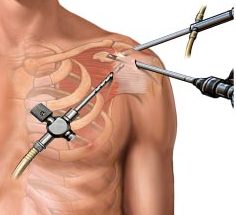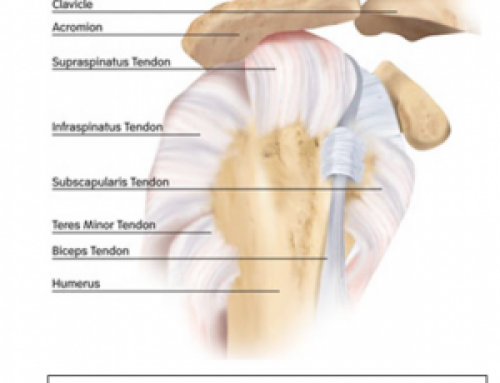The number of reported rotator cuff injuries is increasing in startling numbers. The American Academy of Orthopedic Surgeons reported in a recent study that individuals experiencing rotator cuff problems grew by over 5 million in six years from 1998 to 2004. As the American population bubble ages, so do rotator cuff problems. It is important to know what a rotator cuff injury is and what treatment might be best, and when to consider surgery as the best option.
The rotator cuff is a group of tough tendons, like fibers, and muscles in the shoulder that keep the upper arm bone in the joint socket. A shoulder is comprised of three bones, the upper arm bone, shoulder bone, and shoulder blade. They are held together by muscle, tendons and ligaments. When all is well, the rotator cuff works like a well-tuned machine, providing fluid shoulder function with no pain. However, when shoulder discomfort or increasing pain impedes shoulder function and strength it’s time to consult a doctor.
Symptoms of rotator cuff problems include loss of shoulder function and/or weakness. The AAOS predicts that 5 – 10% of the adult population has rotator cuff issues; ironically, many do not even recognize shoulder discomfort as a possible injury.
Pain occurs when the rotator cuff is irritated or damaged. Tendinitis, inflamed tendon tissue, and bursitis, irritation of the bursa, the cushion between tendons and bone, are typical rotator cuff conditions. Commonly, these conditions and impingement, when tendons are squeezed and rub against bone, are treated with rest, non-steroid inflammatory prescriptions, or cortisone shots.
Rotator cuff problems may also be caused by calcium buildup in the tendons. Because it is important to know where the pain is and why it is occurring, physicians offer alternatives to surgery while continuing to diagnose. Physical therapy, injections, medication, and rest are all recommended, unless a known injury has caused either a parti al or total tear of the rotator cuff.
al or total tear of the rotator cuff.
Partial or complete tear of the rotator cuff occurs either through normal wear and tear or overuse. In males over the age of forty, the rotator cuff naturally starts to deteriorate, and ultimately surgery may be recommended. Thus, as the population ages, rotator cuff tears increase. For people whose frequent activity involves raising arms over their head, such as playing tennis, swimming, weight-lifting, or painting a house, the result is a condition where shoulder tendons squeeze and rub against bone, referred to as impingement.
Success of rotator cuff surgery depends on several factors, including amount of damage, age and health condition of the patient, whether or not the person smokes, and the likelihood of rehabilitation after surgery.
Diagnosis will determine whether surgery is required and what type. Although x-rays confirm tears, MRIs, ultrasound, and arthrography provide a full picture of the tear or tendinitis. The final decision as to whether surgery is needed is also based on the amount of pain. The sooner the tear is repaired, the better results for pain relief and shoulder function, so delaying diagnosis is not a good idea.
Currently, rotator cuff surgery provides higher relief and strength regeneration than non-operative measures, reports the AAOS. Using arthroscopic surgical techniques, need for  hospitalization decreased by 27% by 2004. The shift to outpatient procedures helps meet the growing need for rotator cuff surgery with reduced patient expense.
hospitalization decreased by 27% by 2004. The shift to outpatient procedures helps meet the growing need for rotator cuff surgery with reduced patient expense.




